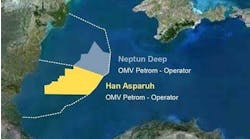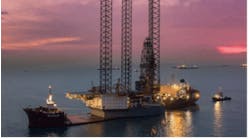Nick Terdre
Contributing Editor
Swift Drilling NV, with NAM and Shell UK, is developing a new jackup rig designed to explore and develop small hydrocarbon prospects in the southern North Sea (SNS). NAM and Shell UK have contracted the first unit, due for delivery in late 2010, for a firm five years with five one-year extension options.
The light offshore drilling unit is designed specifically to drill slim-hole wells in SNS conditions. Significant savings in capital expenditure have been achieved by right-sizing the rig for such a drilling program, says project manager Bastiaan Spruit. In contrast, a conventional jackup rig is over-dimensioned for this task.
Swift’s rig has a tank capacity of 300 cu m (10,594 cu ft) and a hook-load of 280 metric tons (308 tons). It can operate in water depths to 45 m (148 ft), which covers most of the SNS. The design also accounts for the year-round weather conditions.
The relatively low capex for construction of the rig leads to a more favorable day-rate for the customer, the company says. Another aim is lower operating costs, achieved in part through focusing on manpower-reducing measures during the whole design phase, according to the company. The rig is highly automated, including automated pipe-handling. Further crew reductions are achieved by training crew members to handle multiple tasks.
Drilling flexibility
Swift’s rig provides accommodation for up to 66 personnel. However, the standard drilling crew for day- and night-time operations is expected to be about 24, less than half the complement of a conventional jackup. The reduced numbers, in combination with the high degree of automation and a reduced number of offshore lifts, also imply an inherently safer operation.
The rig is built to the GustoMSC SEA-2750 LD design, which features four legs. It incorporates GustoMSC’s X-Y cantilever skidding system, which in addition to 16 m (52.5 ft) forward skidding capacity, can also skid 3.5 m (11.5 ft) to either side, while handling the full load across the entire drilling envelope. This enables it to drill wells side-by-side without repositioning the rig, an option not available to rigs with skidding systems which cannot move laterally. GustoMSC also supplies the jacking system, including the hydraulic power unit.
The Swift rig has a hull measuring 67.4 x 40 x 5.5 m (221 x 131 x 18 ft) and 90 m (295 ft) long legs. Power generation capacity is 7 MW, supplied by three diesel generator sets.
Although optimally designed for slim-hole drilling, the rig can drill conventional wells and perform sidetracks. With its 80-ton (72.6-metric ton) crane, it can lift coiled tubing equipment and handle subsea trees.
The hull, accommodation, and machinery of the first unit are being constructed and assembled at Drydocks World’s Nanindah yard in Indonesia. Final assembly and outfitting of the unit, including installation of the cantilever, will take place at Cofely’s yard at Ijmuiden in the Netherlands.
Swift Drilling NV is a 50/50 joint venture between GDF Suez Energy Services SA and Self Elevating Platforms BV.
“We are really focused on getting this first unit finished, though of course we are interested in expanding our activities,” says Spruit. There has been keen interest from other oil companies in the new drilling unit, he adds. In addition to the SNS, there are other shallow-water hydrocarbon provinces where the Swift rig could be applied, including Southeast Asia, North Africa, the Middle East, and Nigeria.
Swift’s light offshore drilling unit is set to make its entry at a time when the governments in both the Netherlands and UK seek to maximize development of remaining reserves. New measures in the UK budget this spring were designed to stimulate small field development, including those in the southern gas basin.
Sweeping up small gas pockets
NAM/Shell UK’s interest in a light offshore drilling unit should be seen in the context of Project Sweep, a package of cost-effective measures which the companies have assembled for producing the small gas reserves that constitute the bulk of remaining resources in the SNS.
“We have many areas within the SNS which have small gas pockets in the ground, but due to their small size, we have to ensure that we drill for and produce the gas as efficiently and at as low cost as possible,” Walter Slijkerman, cluster development leader for satellites and sweep business opportunity manager, told Shell World UK.
The traditional approach of identifying the best means of development for each field has been discarded by NAM/Shell in favor of standardization. “We look at the entire portfolio of fields and then we put together a single approach to exploring and developing all of them, using the same processes and technology for each field,” said Slijkerman.
The strategy includes slim-line vertical exploration or appraisal wells which will be converted into producers if gas is found. They will be capped with a subsea tree specially developed for the shallow waters of the SNS.
Unlike smaller companies with one or two fields to develop, NAM/Shell has a portfolio of small fields and can invest in equipment up-front, knowing that if one well fails to find commercial gas, the equipment can be used at other locations.




